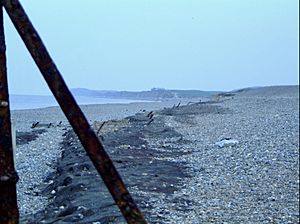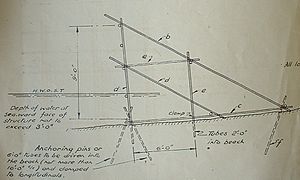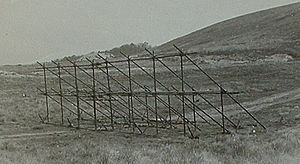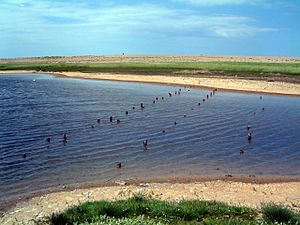Admiralty scaffolding facts for kids

Admiralty scaffolding, also called Obstacle Z.1, was a special type of barrier used by Britain during World War II. It was also known as beach scaffolding or anti-tank scaffolding. This strong barrier was made from steel tubes. Its main job was to stop enemy tanks and boats from landing on British beaches.
Most of these barriers were put up on beaches in southern and eastern England. This happened during 1940 and 1941, when Britain was worried about an invasion. Some scaffolding was also used further inland, but not as much.
What Was Admiralty Scaffolding?
The most common design was called Obstacle Z.1. It was built using tall steel tubes, about 9 feet (2.7 meters) high. These tubes stood about 4 feet 10 inches (1.47 meters) apart. Up to four horizontal tubes connected them. Each tall tube had two diagonal tubes behind it, set at an angle of about 45 degrees, to make it stronger.
Workers would put together sections that were about 20 feet (6 meters) wide. Then, they would carry these sections to the sea. They placed them at the half-tide mark. The idea was to stop enemy boats from reaching the shore.
How Was It Used?
At first, people thought the scaffolding would stop boats. But tests showed that large boats, like a 250-ton barge or an 80-ton fishing trawler, could easily pass through it. A trawler could even pull out a whole section with a rope!
However, tests in October 1940 showed something else. Tanks found it very hard to break through the scaffolding. Because of this, Obstacle Z.1 became an important anti-tank barrier. It was placed on beaches where tanks might try to land. It was put at or just above the high-water mark. This made it difficult for tanks to gain enough speed to crash through.
In some places, two lines of scaffolding were set up. One was in the water to stop boats. The other was at the high-water mark to stop tanks.
Building the Barriers
It was tricky to make the barriers stay firm in the sand. A company called Stewarts & Lloyds came up with a special device called the "sword picket." The British Navy later called it the "Wallace Sword." This device helped to secure the scaffolding.
These barriers were built in many lengths, from a few hundred feet to three miles long. Building them used up half of all the scaffolding steel made in Britain at that time. It cost about £6,600 per mile in 1940. That would be like spending about £450,000 today. Even with the high cost, many miles of Admiralty scaffolding were built. More than 15,000 miles (24,000 kilometers) of scaffolding tube were used!
After the war ended, the scaffolding was no longer needed. It got in the way of people swimming in the sea. So, most of it was removed and sold for scrap metal. Today, it is very rare to find any parts of it. But sometimes, big storms can uncover old pieces on the beaches.
See also




